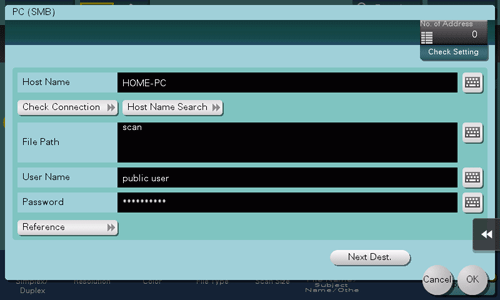
PC (SMB)
To display:
- [Classic Style]
- [Scan/Fax]
- [Direct Input]
- [PC (SMB)]
- [Direct Input]
- [Scan/Fax]
Directly enter destination information for SMB transmission.

Setting | Description |
|---|---|
[Host Name] | Enter the destination computer name (host name) or full computer name (FQDN) (using up to 253 bytes). If you cannot specify the computer name or full computer name, enter the IP address.
|
[Check Connection] | Check whether or not the host name you specified in [Host Name] exists. |
[Host Name Search] | Searches for the host name to be applied to [Host Name]. To search for the host name, specify a group name.
|
[File Path] | Enter the shared folder name of the host specified in [Host Name] (using up to 255 bytes).
|
[User Name] | Enter the name of a user with folder access rights (using up to 64 characters). |
[Password] | Enter the password (using up to 64 characters, excluding double quotation mark ") to access the folder. |
[Reference] | Specify the shared folder of the desired computer by reference to the network. When the authentication screen appears, enter the name and password of the user who has privileges to access the shared folder. After authentication, [Host Name] and [File Path] are set automatically. The Reference function may fail under the following conditions.
|
[Enable Auth. Verification] | Select this option to perform authentication for the destination before sending data. To execute authentication, tap [OK] or [Next Dest.]. [Enable Auth. Verification] is displayed when:
|